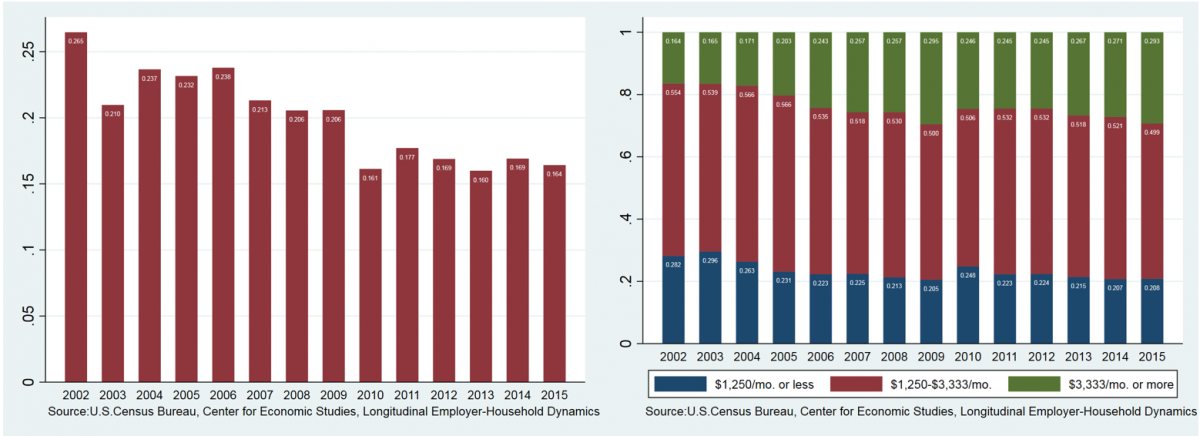Assessing Strategies for Economic Revitalization in Camden, New Jersey, and Other Distressed Cities
Camden, New Jersey, like many American cities, suffered decline in the latter half of the 20th century as the manufacturing base and middle-income residents left for outlying suburban areas. Loss of industry and manufacturing increased poverty and economic and racial inequalities in cities that had driven America’s economic growth from the 19th into the 20th century. Although some U.S. cities started to rebound in the 1990s, others, like Camden, have stagnated or continued to decline. In many places, attempts at economic revival have failed to benefit most residents – and have especially failed the most disadvantaged households. Mismanagement and corruption often accompany economic decline, as they have in Camden -- which has suffered from an ineffective city council and mayors who have faced charges of misconduct.
The New Jersey Municipal Distress Index
Decline and improvement can be tracked with some precision for Camden and other New Jersey cities, because in 1996 the Department of Community Affairs issued the 1996 New Jersey Municipal Distress Index using a range of indicators:
- Social indicators: percent population change and change in the number of children receiving federal welfare assistance;
- Economic indicators: per capita income, unemployment rate;
- Fiscal indicators: equalized three-year local tax rate, equalized valuation per capital;
- Physical infrastructure indicators: pre-1940 housing stock, percent substandard housing.
Since its creation, Camden has ranked very low on this index, experiencing only slight improvement lately in a period when other New Jersey cities have made greater gains, according to research I have done with my colleague David Okereke. The index can be a useful tool for evaluating the effectiveness of various local level policies aimed at economic development – such as the New Jersey Economic Opportunity Act passed in 2013 to combat disinvestment in urban cores by using tax breaks and other financial incentives to attract new businesses.
In Camden, this legislation has had mixed effects. In the past few years, it has encouraged new development that has changed the city’s physical landscape in the downtown and waterfront areas. But the jobs picture has not improved. Local job creation largely trended downward between 2002 and 2015. By 2015, monthly earnings patterns resembled pre-recession 2009 patterns, and the share of local jobs held by residents continued to linger around 16 percent in 2015, virtually unchanged from 2010, the year the recession was worst and a state takeover of local Camden government ended. Very recent new job creation in Camden is probably due to transfers from the surrounding Southern New Jersey suburbs. Overall, therefore the indicators we can track suggest that the Economic Opportunity Act and other New Jersey policies have been largely ineffective in reversing long-term unemployment and other economic disadvantages for Camden city residents.
Percent of Jobs Occupied by City Residents* Percent Earnings of City Resident-Workers

* adjusted for local job-labor force mismatch (shortfall)
Policy Pathways Forward
Our work probes the underlying forces perpetuating economic distress in cities like Camden, using data from the U.S. Census, the American Community Survey, and a comprehensive review of official government records, publications, press releases, and news reports. Based on that work, we offer suggestions for more effective policies to reverse urban economic decline and distress.
- Leverage local human and social capital. New policies and strategies should start from the premise that the labor force helps shape urban capabilities. By focusing on existing social resources and human capital, state and local governments can do more to increase economic productivity throughout the Southern New Jersey region. Worker-owned co-ops could serve as a useful tool for building upon local strengths and resources.
- Bring everyone to the table in Community Benefits Agreements. Because local support and commitment are essential to success, development efforts must rest in negotiated agreements that include local grassroots and community based organizations as well as businesses and nonprofit groups. All of these partners must come together to revitalize Camden’s downtown and outlying neighborhoods.
- Learn from best practices in other regions. According to our research, the Evergreen Cooperative in Cleveland, Ohio offers a useful case study and lessons about what has worked in the Midwest to address urban problems similar to those that plague Camden and other northeastern cities. Those working for urban revitalization in New Jersey can benefit from a broad survey of steps that have been successful elsewhere.
